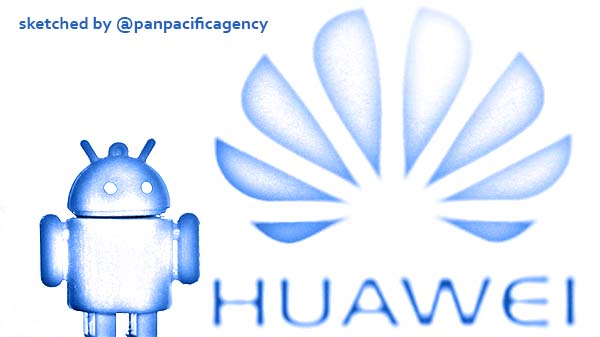[Analytics] Huawei outpaces rivals with chip sanctions ploy

A 3-D printed Android logo is seen in front of a displayed Huawei logo © Reuters / Dado Ruvic. Sketched by the Pan Pacific Agency.
In a rare bonanza before United States sanctions kick in, Chinese tech giant Huawei shipped more smartphones worldwide than its competitors in April, according to Hong Kong-based market consultants. Frank Chen specially for the Asia Times.
Huawei took a commanding market share of 21.4% of the 69.37 million handsets sold around the world, Counterpoint Research said.
Huawei, a lightning rod for Washington’s efforts to squeeze Chinese companies, pulled off a surprising upset and outstripped Samsung in April. Its fortune was buoyed up by its resilient home market, where it enjoyed a 44% stranglehold that month.
Peter Richardson, Counterpoint’s vice-president of research, said Samsung had been hamstrung by the 96% month-by-month slump in handset sales in India, one of its key markets, while the steady uptick in mainland China gave Huawei a crucial tailwind.
But Huawei may not have time to relish the achievement. One month has lapsed since May 15 when Washington banned the shipment of any chips or components made with American know-how.
The Shenzhen-based telecommunications manufacturer now has three months left until September, a buffer period granted by the US, to take delivery of orders placed before mid-May.
The US Department of Commerce and the Bureau of Industry and Security has revised its foreign-produced direct-product rule and its related entity list to “narrowly and strategically target Huawei’s acquisition of semiconductors that are the direct product of certain US software and technology.”
In an 11th-hour decision in response, Huawei reportedly scrambled in early May to order about US$700 million worth of 7-nanometer chips from its key supplier TSMC, having got wind of the additional sanctions.
It is believed that Huawei is sitting on a massive inventory of chips and other key components, enough to power future models at least for the rest of the year.
However, some chips will become outmoded when TSMC and other companies launch newer chips along with new handsets that will hit the market later this year.
Taipei-based China Times quoted TSMC founder Morris Chang as saying its wafer plants in Taiwan’s Hsinchu and Tainan had been working flat out churning out as many chips for Huawei as possible since May and that the semiconductor company had even talked to its other clients inducing Qualcomm, Nvidia, AMD and MediaTek to reschedule production to fit in orders from Huawei.
Chang stressed that TSMC would comply with US laws and cut off dealings with Huawei after the buffer period, adding that Apple’s new orders for its latest iPhone models would help TSMC claw back a big chunk of the lost sales.
Huawei was TSMC’s second largest client, contributing 14% of its total revenues in 2019. At an annual general meeting last week, TSMC chairman Mark Liu also revealed that several other customers from the US would buy more from the chipmaker to fill the gap left by Huawei.
TSMC has also sought to refute rumors that Huawei subsidiary HiSilicon would share its $12 billion outlay for an advanced 5-nm wafer foundry to be built in Arizona.
The new toll taken on Huawei has also seen Taiwan’s MediaTek and the Shanghai-based SMIC forgo fat orders from Huawei this month. Just like TSMC, MediaTek and SMIC also rely on US technology to produce chips.
Huawei’s antennae are also up in search of alternative chip suppliers.
It is said that Huawei is in talks with Samsung for a market-share-for-chips deal, under which Huawei has offered its smartphone market share in exchange for 5G chips from Samsung that will be manufactured with other Korean and Japanese foundries that do not use US equipment or technology.
Huawei is said to be willing to give up some of its share of the Chinese market to help Samsung’s smartphones, an underdog lagging behind Huawei, Xiaomi, Oppo and Apple, to regain its footing there.
China Business News reported last week that Huawei had shifted its focus back to backbone equipment and carrier business for a renewed pitch to promote its 5G gear and solutions across Southeast Asia and continental Europe in the advent of a new era of telecom services, but its core 5G business is also hobbled by Washington’s chip embargo.
Still, it remains to be seen if Samsung will use the photolithography systems from the Dutch company ASML Holding to manufacture chips for Huawei, as the latter’s equipment for the production of integrated circuits uses extensive US technology and ingenuity.
The latest news from Washington on Tuesday, however, may be reassuring for Huawei. The US Commerce Department has decided to tweak its ban to allow for US companies to develop joint and streamlined 5G technology and standards with overseas counterparts, including Huawei.
“This action is meant to ensure Huawei’s placement on the Entity List in May 2019 does not prevent American companies from contributing to important standards-developing activities despite Huawei’s pervasive participation in standards-development organizations,” the department said.
It remains unclear if the latest change will give leeway for Huawei to source chips and parts more easily, at least for its 5G business, but the ban on smartphone chips from TSMC and operating systems like Android is unaffected.